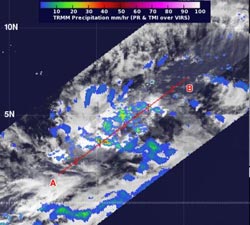NASA spots heavy rainfall in Tropical Depression 26W threatening Micronesia

NASA's TRMM satellite passed over Tropical Depression 26W on Nov. 26 at 0526 UTC. The data showed that the depression's low-level center was large, and it had some fragmented convective bands of thunderstorms wrapping around it that contained heavy rain (in red), falling at 2 inches/50 mm per hour. TRMM data also revealed tall convective towering thunderstorms about 15 kilometers (9.3 miles) high.<br><br>Credit: NASA/SSAI, Hal Pierce<br>
Micronesia is a region in the western North Pacific Ocean made up of thousands of small islands. West of the region is the Philippines, while Indonesia is located to the southwest.
NASA's Tropical Rainfall Measuring Mission (TRMM) satellite passed over Tropical Depression 26W on Nov. 26 at 0526 UTC (12:26 a.m. EST). The imagery showed that the depression's low-level center was large, and it had some fragmented convective bands of thunderstorms wrapping around it that contained heavy rain, falling at 2 inches/50 mm per hour. TRMM data also revealed tall convective towering thunderstorms about 15 kilometers (9.3 miles) high. According to previous NASA research, those “hot towers” usually signify that a tropical cyclone will intensify.
According to NOAA's National Weather Service in Tiyan, Guam, a tropical storm warning remains in effect for Nukuoro in Pohnpei State and Lukunor in Chuuk State. A tropical storm watch remains in effect for Losap and for Chuuk Lagoon Islands in Chuuk State.
A tropical storm warning means tropical storm conditions, including damaging winds of 39 to 73 mph are expected within 24 hours while a tropical storm watch means that tropical storm conditions are possible within 48 hours.
At 1500 UTC (10 a.m. EST) on Nov. 26, 2012, Tropical Depression 26W (TD26W) was centered near 4.8 degrees north latitude and 155.1 degrees east longitude. That put TD26W's center about 65 miles north of Nukuoro, 95 miles southeast of Lukunor, and 215 miles southeast of Losap. The National Weather Service noted that TD26W is moving west-northwest at 7 mph and is expected to move in a more westerly direction and slightly speed up over the next day. Maximum sustained winds are near 35 mph, and could become a tropical storm later today, Nov. 26.
Forecasters at the Joint Typhoon Warning Center expect Tropical Depression 26W to track to the west-northwest over the next several days and strengthen to typhoon status as it tracks through the warm waters of the Philippine Sea. TD26W is forecast to pass just south of Chuuk and affect Yap and Palau by the weekend of Dec. 1 and Dec. 2.
Media Contact
More Information:
http://www.nasa.govAll latest news from the category: Earth Sciences
Earth Sciences (also referred to as Geosciences), which deals with basic issues surrounding our planet, plays a vital role in the area of energy and raw materials supply.
Earth Sciences comprises subjects such as geology, geography, geological informatics, paleontology, mineralogy, petrography, crystallography, geophysics, geodesy, glaciology, cartography, photogrammetry, meteorology and seismology, early-warning systems, earthquake research and polar research.
Newest articles

Superradiant atoms could push the boundaries of how precisely time can be measured
Superradiant atoms can help us measure time more precisely than ever. In a new study, researchers from the University of Copenhagen present a new method for measuring the time interval,…

Ion thermoelectric conversion devices for near room temperature
The electrode sheet of the thermoelectric device consists of ionic hydrogel, which is sandwiched between the electrodes to form, and the Prussian blue on the electrode undergoes a redox reaction…

Zap Energy achieves 37-million-degree temperatures in a compact device
New publication reports record electron temperatures for a small-scale, sheared-flow-stabilized Z-pinch fusion device. In the nine decades since humans first produced fusion reactions, only a few fusion technologies have demonstrated…





















